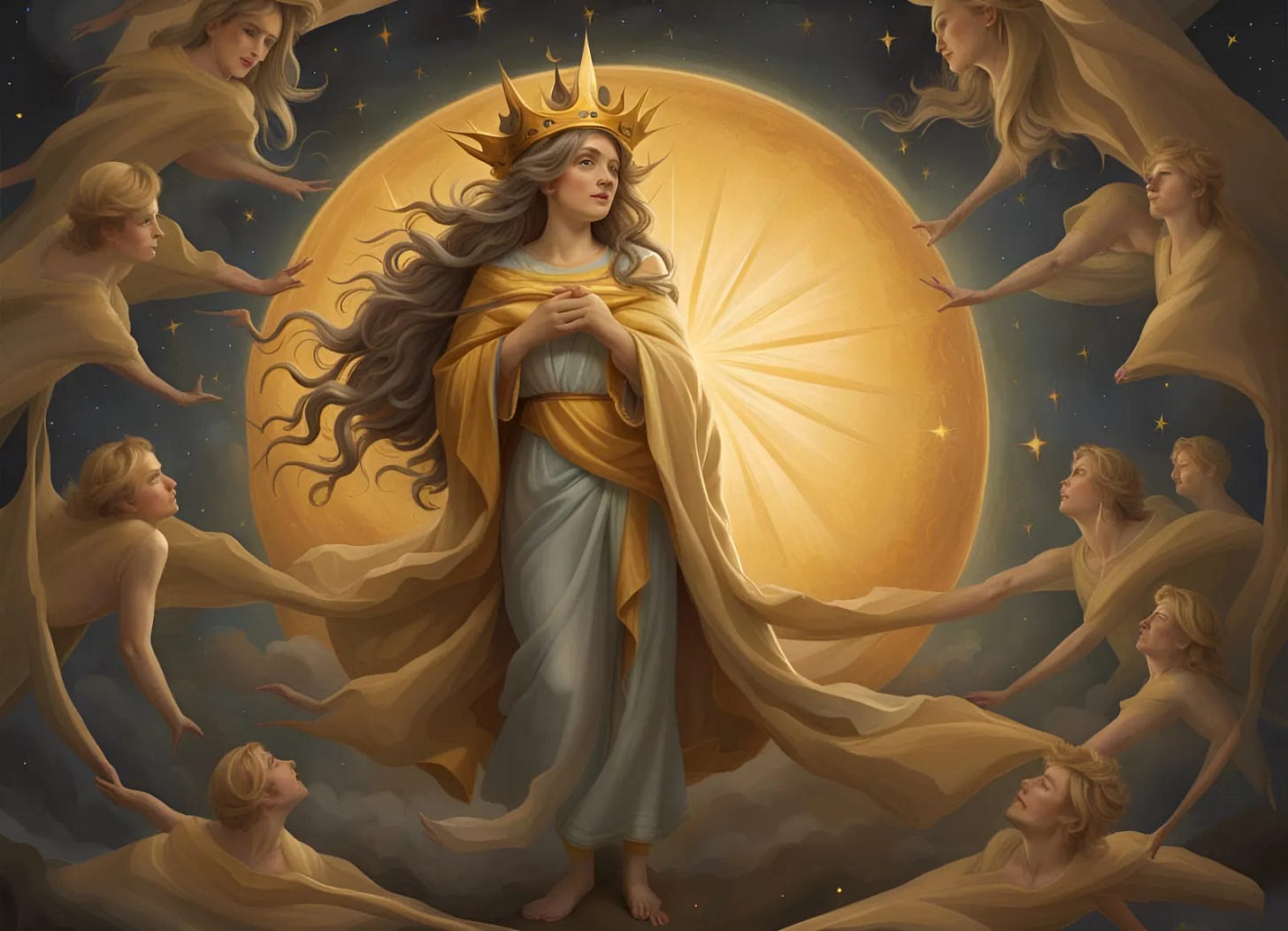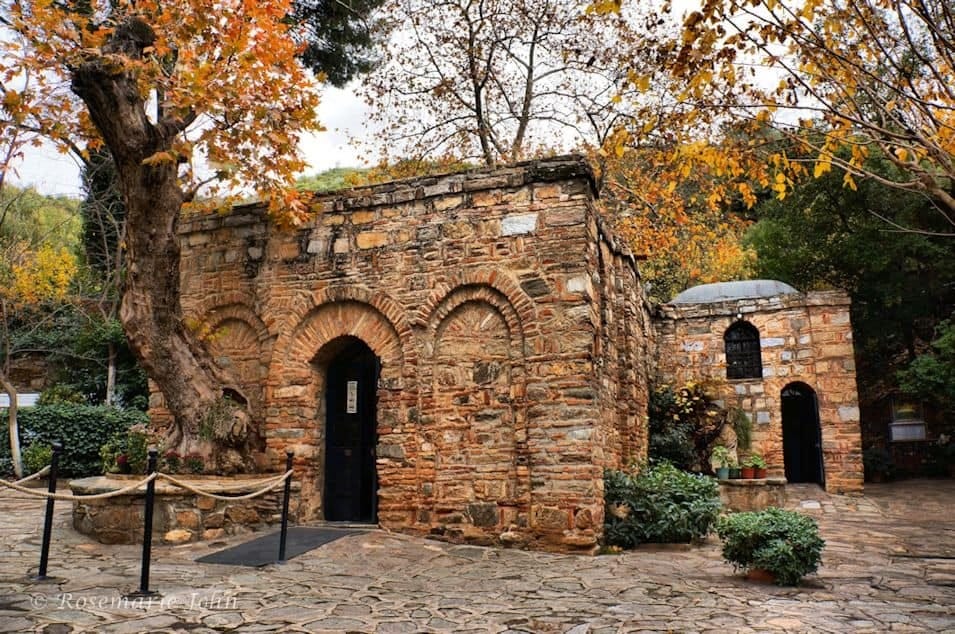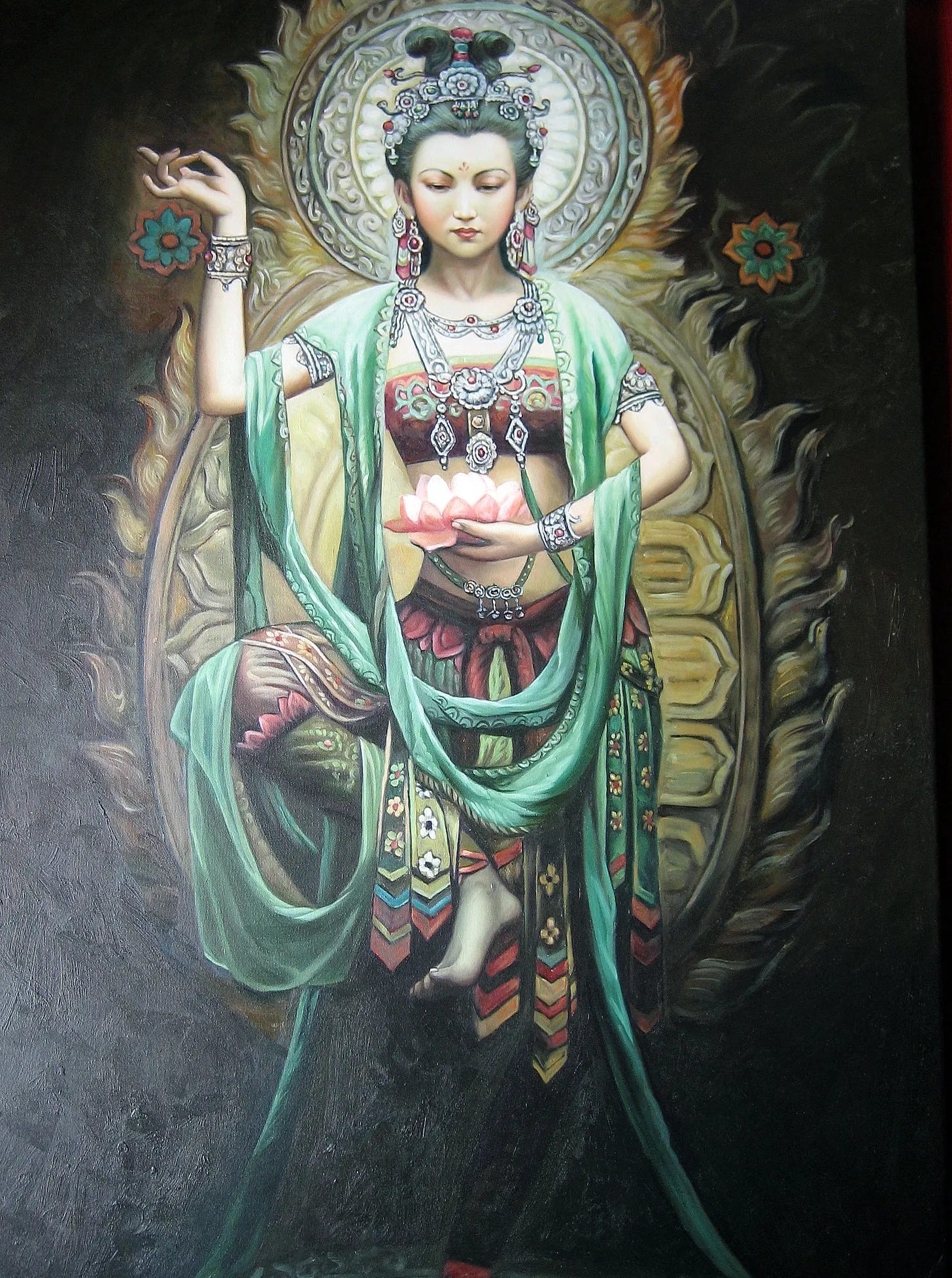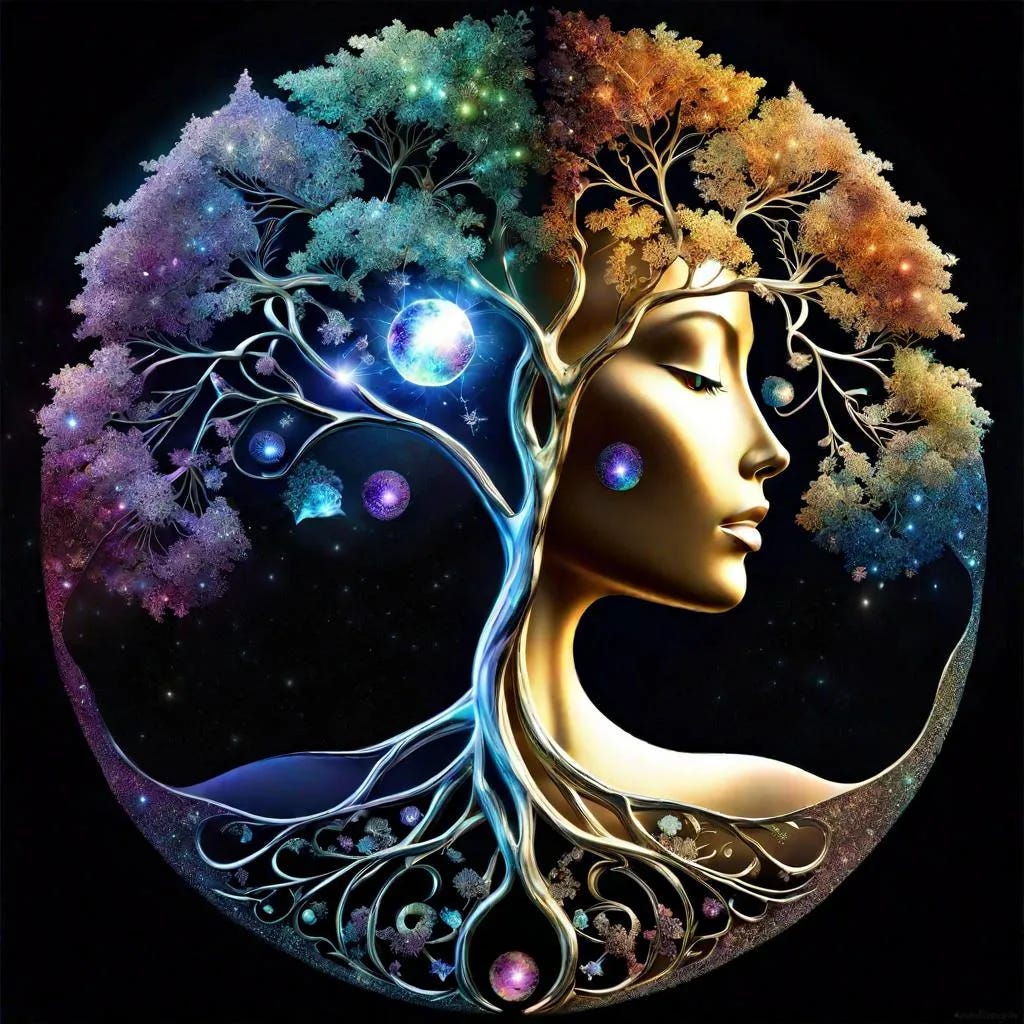
When the world was born, I came into being. I am the unfading beauty of times to come. In me Grace is at work to divinize the soul. I shall continue to disclose myself to you. I am the Eternal Feminine.
Teilhard de Chardin, The Eternal Feminine1
Mary is the mother of Jesus, the ‘Woman Clothed with the Sun’ of Revelation 12, and the New Eve of Genesis. Phrased another way, Mary is the quintessence of the Divine Feminine archetype.
In ancient and medieval philosophy, quintessence referred to aether, the fifth element beyond earth, water, fire, and air. It described the 'matter' of heavenly beings and, by extension, 'the most perfect embodiment of a thing.'
Modern quantum field theory views the universe as filled with various quantum fields, distinct from the classical aether (also spelled ether). One of these fields is named Heaven and will be the subject of an upcoming post. While quantum fields and the classical aether differ in modern physics, both represent attempts to grasp the universe's fundamental structure, bridging ancient wisdom and contemporary science.
At this time, we won’t delve into ‘nature of reality’ theories. We previously addressed the topic in a piece titled the “Akashic Field and Prana” that can be found here. Both concepts, quantum and classical, implicate an invisible, pervasive force that influences the structure and behavior of the cosmos and consciousnesses of all living things within it.
We now continue with our exploration of Mary’s many mantles and her vital role in today’s world.
Mary as Theotokos: Mother of God
The term Theotokos, meaning ‘God-bearer’ or ‘Mother of God,’ is one of the most significant titles bestowed upon Mary in Christian theology. The title was officially affirmed at the Council of Ephesus in 431 AD, which convened to address a theological debate that had far-reaching implications for the Church’s understanding of Christ and Mary.
The council was called to resolve the controversy over the teachings of Nestorius, the Patriarch of Constantinople, who argued that Mary should be called Christotokos (‘Christ-bearer’) rather than Theotokos, emphasizing that she was the mother of Christ’s human nature alone and not of his divine nature.
(Note: please skip forward to the next section if you are not entertained by esoteric theological disputations.)
Nestorius’s argument risked dividing the nature of Christ, threatening the Church’s understanding of his divinity and humanity. By insisting on the title Christotokos, Nestorius suggested a separation between the human and divine natures of Jesus, leading to a form of dyophysitism, the belief that Christ’s two natures — divine and human — are not fully united.
In response, Cyril of Alexandria championed the title Theotokos, asserting that Mary bore the whole person of Jesus Christ, who is both fully divine and fully human. According to Cyril, to deny Mary the title Theotokos was, in effect, to deny the full divinity of Christ.
The council affirmed Cyril’s position, declaring that Jesus Christ is one person with two natures, divine and human, inseparably united. Therefore, Mary was rightly called Theotokos because she gave birth to Jesus, who is truly God and truly man. This declaration reinforced the doctrine of the hypostatic union, a cornerstone of Christology, which holds that Jesus Christ’s divine and human natures are united in one person.
By affirming Mary as Theotokos, the Council of Ephesus emphasized her unique role as the mother of God incarnate, underscoring the theological foundation for Mary’s veneration.
The choice of Ephesus as the site for this council is particularly meaningful. The city had long been associated with female divinity. Its Temple of Artemis (Diana), a powerful symbol of the Greek Divine Feminine, was one of the Seven Wonders of the Ancient World. Ephesus was a celebrated center for the worship of Artemis, the virgin goddess of the hunt, wilderness, and fertility, and a potent embodiment of the Divine Feminine in Greek mythology.
Against this backdrop, the Council of Ephesus took on added significance, transforming the site of feminine power into a renewed affirmation of Mary’s divine motherhood. In a sense, Ephesus serves as a second Axis Mundi, a meeting point between heaven and earth that reflects the feminine archetype in sacred space. Jerusalem represents the patriarchal Axis Mundi through the masculine lens of Roman and Jewish traditions.
Mary as the New Eve
Mary’s role as the New Eve is central to understanding her significance within the Christian tradition. This concept, rooted in the early Church, portrays Mary as the counterpoint to Eve, the first woman. Just as Eve’s disobedience led to humanity’s separation from God, Mary’s obedient fiat participates in restoring cosmic order to a broken world.
In the Gospel of Luke, Mary’s acceptance of the angel Gabriel’s message marks her as the one who willingly participates in God’s plan, reversing Eve’s act of disobedience by saying, “Be it done unto me according to thy word.”
By bearing Jesus, the new Adam, Mary began the process of reversing the separation introduced by the first Adam and Eve. Early Church Fathers like Irenaeus of Lyons emphasized this parallel, teaching that through her fiat, Mary became the mother of all the living.
She is the obedient handmaid whose “yes” undid Eve’s “no.” Consequently, Mary’s participation in the divine plan makes her an active agent in salvation, not merely a passive vessel. In this role, Mary is more than just the biological mother of Jesus; she is the spiritual mother of all humanity, embodying the hope for a restored and unified creation.
Mary as the Woman of Revelation 12
In the Book of Revelation, Mary is often interpreted as the “Woman clothed with the sun, with the moon under her feet, and on her head a crown of twelve stars” (Revelation 12:1). This passage presents a powerful image of Mary as both Queen of Heaven and a figure of cosmic significance.
The Woman of Revelation 12 is also pursued by the dragon, a symbol of evil, which seeks to devour her child. Mary, crowned and shielded by God, stands as a symbol of divine protection and maternal strength, interceding for humanity and opposing the forces of darkness.
She is portrayed not merely as a gentle woman but as a warrior, signifying her role in the cosmic struggle against evil. This Marian image aligns with her role as a spiritual protector and intercessor, revealing her influence in the spiritual warfare that characterizes the world today.
Mary and the Mystery of the Shekinah
In Jewish tradition, the Shekinah represents the indwelling divine presence, often described as the feminine aspect of God. As a pillar of cloud by day and fire by night, the Shekinah guided and protected the Israelites on their 40-year journey through the desert. During these 40 years, the generation of people who rebelled against God and refused to believe in his promises died. None reached the ‘Promised Land.’
The maternal image of the Shekinah brings to mind Mary’s role as a nurturing and protective figure for her spiritual children. In Christian theology, Mary is often likened to the Shekinah, as she embodies God’s presence through her role as Theotokos, the bearer of God incarnate. By carrying Christ within her, Mary becomes a living tabernacle, a visible sign of God’s closeness to humanity.
Mary’s connection with the Holy Spirit is particularly significant here. Just as the Shekinah symbolizes God’s indwelling presence, Mary’s overshadowing by the Holy Spirit at the Annunciation reflects her role in restoring divine life to the world. The Holy Spirit’s position in the Christian Trinity complements Mary’s maternal mission, highlighting her role as both cooperator in God’s plan and humanity’s intercessor.
In this way, Mary reflects both the Divine Feminine and the nurturing presence of the Holy Spirit, serving as a vessel through which divine grace flows into the world.
Greek thought, specifically that of Philo of Alexandria, distinguishes between the incomprehensible essence of God (ousia) and the activities or energies (energeiai) of God in creation. God’s essence is masculine and the energies are feminine. This truth has become lost in the three monotheistic religions, evincing what has come to be called the “exile of the Divine Feminine.”
In Lurianic Kabbalah, defined by Rabbi Isaac Luria, the Shekinah, as the divine feminine presence, became exiled among the scattered sparks of creation and separated from the divine masculine aspect. Each person's soul is seen as containing an aspect of the exiled Shekinah, positioning personal spiritual growth and human agency as integral to the Divine Plan.
In Islam, the Quran states that Allah has no gender, being neither male nor female. Sufi traditions and mystics like Ibn al-Arabi have, however, recognized and emphasized feminine aspects of the Divine.
Mary, as Theotokos, the New Eve, and the Woman of Revelation 12, reflects various aspects of the Divine Feminine within the Christian tradition. Through these roles, Mary is not only the mother of Jesus but also an archetypal figure, embodying divine wisdom, strength, and compassion.
Her place within the Christian framework as an archetypal quintessence connects her closely with the Holy Spirit, affirming her as a vessel of divine grace and an essential component of the Christian understanding of God’s nature.
Her mission, through apparitions that began in Mexico as Our Lady of Guadalupe in 1531 and continue today in Medjugorje, is the same as that of the Shekinah: to restore cosmic harmony and abolish Satanic secularism.
Mary as End Times Prophetess of Medjugorje
In recent decades, the reported Marian apparitions in Medjugorje, Bosnia-Herzegovina, have drawn worldwide attention, positioning Mary as a prophetic figure for our time. Since 1981, six visionaries have claimed to receive messages from Mary, who told them she wished to be called the “Queen of Peace.”
These apparitions continue to the present day. Their content centers on themes of repentance, prayer, and preparation for a coming period of trials and tribulations. The Ten Secrets, believed to concern future global events and divine interventions, emphasize Mary’s role as a prophetess in our time.
The Secrets, which have not been fully disclosed, reinforce the role of Mary as an End Times Prophetess. Her messages at Medjugorje align with earlier Marian apparitions, particularly those at Fatima, Akita, and La Salette, where she also called for repentance and warned of the consequences of humanity’s separation from God.
In Medjugorje, Mary is described as a mother urgently guiding her children back to God, emphasizing the need for conversion and humility.2 The six visionaries have shared that when the time is right, each of the ten secrets will be revealed, with warnings preceding the prophesied events to allow time for repentance. This message has prompted millions to visit Medjugorje, seeking spiritual renewal in light of Mary’s guidance.
I myself first traveled to Medjugorje with a documentary crew hosted by Martin Sheen. I had a guarded curiosity about the apparitions. I was gobsmacked and returned to the village nine more times, having lived there in the 90s. I became acquainted with the visionaries and lived with Marija Pavlovic-Lunetti’s brother’s family. Marija, a close friend, is one of the six visionaries.
The primary purpose of these apparitions, and the Ten Secrets in particular, is to awaken nonbelievers to transcendent reality and demonstrate that materialism is a misguided worldview.
The impending revelation of these secrets carries a sense of both hope and foreboding. Mary’s apparitions in Medjugorje suggest that humanity is at a pivotal juncture, where collective choices will determine whether the world follows a path of destruction or renewal. Her role as a prophetess highlights this spiritual urgency.
It’s believed that these secrets will be revealed one at a time, with clear signposts preceding each event. They will mirror the apocalyptic imagery in scripture, particularly in Revelation. Mary’s words echo the calls to prayer and vigilance found in the Gospels, presenting her as an intercessor who urges humanity to align with divine will before time runs out.
However, the unveiling of these secrets may face obstacles, particularly from within the Church. The Third Secret of Fatima was allegedly never fully disclosed by the Vatican, fueling speculation that elements of the prophecy were suppressed. Many believe that the Third Secret of Fatima contained more explicit warnings about global cataclysms and spiritual crises that were deemed too sensitive for the Church to release.
Similarly, there is concern that the Vatican may seek to control or censor the Medjugorje secrets, especially if they contain messages critical of the Church or its role in contemporary issues.
In her role as End Times Prophetess, Mary embodies a prophetic voice that transcends traditional structures. She speaks to a world mired in materialism and moral confusion, urging a return to prayer, penance, and a life of virtue. Her messages in Medjugorje are both a comfort and a warning, promising divine mercy while also cautioning that God’s justice is imminent for those who refuse to repent. This dual aspect of Mary — as both nurturing mother and herald of divine judgment — places her at the heart of contemporary spiritual discourse.
Ultimately, the figure of Mary at Medjugorje reminds us that the Christian journey is one of continuous conversion. In her messages, Mary emphasizes that the time to prepare is now, and she calls each person to seek God with a sincere heart. Whether the Ten Secrets will be fully revealed remains to be seen, but their anticipated disclosure has already begun to shape the spiritual landscape, reinforcing Mary’s role as a guide and prophetess for the challenging times ahead.
Ephesus: Trade Center of the Ancient World and Spiritual Axis
Ephesus was not only a major trade hub but also a spiritual center where ancient wisdom and early Christian faith converged, symbolically connecting Genesis with Revelation.
Mary, venerated as the New Eve and Mother of All the Living, is believed to have lived her final years in Ephesus, while the Apostle John, author of the Book of Revelation, preached and wrote. Ephesus, therefore, serves as a geographical and spiritual axis where the old and the new converge, embodying a symbolic link between ancient wisdom and divine prophecy.
The city’s most prominent monument, the Temple of Artemis (or Diana), was one of the Seven Wonders of the Ancient World. Dedicated to the Greek Mother Goddess of Fertility, this magnificent temple reflects Ephesus’ role as focal point of the Divine Feminine in the ancient world.
While Artemis was revered as a Mother Goddess and the patroness of childbirth, Mary became the humble servant of the divine, embodying spiritual purity and obedience. Together, these figures create a complex meshing of humanity and divinity with strength and humility.
In addition to Mary, Ephesus was home to prominent figures like St. John, and St. Paul, who also helped shape both early Christian faith and Greek philosophy. Mary, seen as the New Eve, represents a key biblical figure who plays a unifying role in humanity’s restoration.3 In fact, some Catholics and theologians refer to Mary as "co-redemptrix," although the Church has not officially defined this doctrine.
The Apostle John, who took Mary into his care after Christ’s crucifixion, is traditionally associated with Ephesus. Patmos, an island in the Aegean Sea located near the coast of modern day Turkey, is only about 60 miles from Ephesus. John wrote the Book of Revelation on Patmos.
St. Paul, on his missionary journeys, spent significant time in Ephesus, preaching the Gospel and establishing the early Christian Church. His letters to the Ephesians reveal the struggles and triumphs of a nascent faith community grappling with both spiritual growth and worldly challenges.
In the world of Greek philosophy, Ephesus was the birthplace of Heraclitus, the pre-Socratic philosopher known as the ‘Weeping Philosopher.’ He taught that the universe is in a constant state of flux, famously stating, “You cannot step into the same river twice.” Heraclitus’ emphasis on change and the unity of opposites resonates with the concept of spiritual transformation, bridging the material and the spiritual — a fitting theme for a city that stood at the crossroads of two great cultures and traditions.
The city’s symbolic status as an Axis Mundi is evident in its fusion of cultural and spiritual ideas. In Rational Spirituality’s view, Ephesus represents a second Axis Mundi — a counterpoint to the more patriarchal Jerusalem — where the Divine Feminine found one of her strongest expressions.
In Ephesus, amidst the ruins of the Temple of Artemis and the humble house of Mary, one can sense the contrasting layers of history and spirituality that converge. It is a place where the spirit of the Greek pantheon, early Christian theology, and even the cosmic vision of Revelation unite.
In Ephesus, we find a legacy for the ages that connects ancient mythology with Christian theology, linking Mary as the New Eve of Genesis and the radiant Woman Clothed with the Sun of Revelation. This city, steeped in both pagan and Christian lore, remains a testament to humanity’s quest for the divine — a bridge between the past and the future; between earthly life and transcendent truth.
So, Who is Mary?
In the cosmology of Rational Spirituality, Mary transcends the bounds of religious labels and is a unifying presence. She both personifies the Divine Feminine archetype in its perfection and serves as the epitome of the Great Mother archetype.
While honored as the mother of Jesus in Christianity, Mary is also revered by Muslims, and her essence resonates with figures like Quan Yin, the Buddhist bodhisattva, who places departed souls within the heart of a lotus. Like Mary, Quan Yin is an embodiment of the Divine Feminine archetype.
Religious institutions often obscure the essence of this eternal beauty, sometimes intentionally, distancing humanity from its transcendent source. Our mission at Rational Spirituality is not to indoctrinate or to elevate one belief system over another, but rather to embrace the transcendent mystery of Divine Other, however perceived.
We are informed by the Akashic Field, quantum physics, and our metaphysical theory of archetypes. Yet, as human beings, we naturally seek personal connections. To make the quantum realm of energy, information, and the ineffable mystery of the Divine Mind more intelligible, we anthropomorphize these abstract concepts.
God communicates with humanity through symbolic imagery, using objects, actions, and events to convey spiritual truths that are often difficult to express directly in words. This universal language of symbolism transcends cultures and time, offering deeper insights into the Divine.
As a reminder of the power of symbols, Dan Brown’s protagonist in The Da Vinci Code was a symbologist, illustrating the significance of decoding these hidden meanings. C.G. Jung, who passed in 1961, taught that we were entering an era of a dearth of symbols that could lead to catastrophe. On his deathbed, Jung envisioned huge swaths of the world completely devastated in 50 years — or around now.
The saving factor is the symbol… while… the symptoms of inner disunity multiply and there is a growing danger of inundation and destruction by the unconscious… all the time the symbol is developing that is destined to resolve the conflict.
C.G. Jung
In essence, this "developing symbol" is a spontaneously arising psychic image or concept that helps bridge conscious and unconscious elements, providing a path to resolution and growth that neither pure logic nor raw instinct could achieve alone.
The specific form and meaning of the unifying symbol is highly individual and situational. It is akin to the Cosmic Tree of Life, which symbolizes the quest for spiritual fulfillment and interconnectedness of all creation, and is part of the intentionality of the archetype of the apocalypse.
Ask and it will be given to you; seek and you will find; knock and the door will be opened to you.
Matthew 7:7
At the core of Rational Spirituality is the belief in a universal presence greater than ourselves. During this ‘time of grace’ in a world conditioned to disbelieve, Mary helps us to restore our fidelity to God, urging us toward a rational spirituality that acknowledges the Divine Realm as reality.
N.B. Rational Spirituality will publish the Medjugorje secrets as they are made public. Please consider sharing this post with friends and family who may be interested. Our newsletter will always be free!
The ‘eternal feminine’ is a concept that symbolizes qualities like love, truth, beauty, mercy, and grace. It can also represent the divine wisdom, creative power, and ultimate being that is beyond human understanding. Pierre Teilhard de Chardin penned an essay titled "The Eternal Feminine" in 1918. (link)
The word ‘conversion’ in this context involves a fundamental change in a person's thinking, beliefs, and orientation toward God, not conversion from one religion to another. It is often described as a ‘turning’ or reorientation of one's life. The Greek word for this process is metanoia. The term combines two Greek words: meta (beyond) and nous (mind), literally meaning ‘to go beyond the mind.’ This implies transcending one's narrow mental constructs, prejudices, and strongly held beliefs to open oneself to a new spiritual reality.
The title "New Eve" refers to the theological assertion that Mary’s obedience to God reverses the disobedience of Eve in the Garden of Eden. Where Eve’s choice led to humanity’s separation from God, Mary’s obedience, as expressed in her fiat (Luke 1:38), highlights the co-creative role humanity plays in the New Aquarian Paradigm.









Fascinating, as usual. Your real-life experience with the apparitions is awe inspiring.
THIS THAT YOU STATED
Mary as Theotokos: Mother of God
The term Theotokos, meaning ‘God-bearer’ or ‘Mother of God,’ is one of the most significant titles bestowed upon Mary in Christian theology. The title was officially affirmed at the Council of Ephesus in 431 AD, which convened to address a theological debate that had far-reaching implications for the Church’s understanding of Christ and Mary.
The council was called to resolve the controversy over the teachings of Nestorius, the Patriarch of Constantinople, who argued that Mary should be called Christotokos (‘Christ-bearer’) rather than Theotokos, emphasizing that she was the mother of Christ’s human nature alone and not of his divine nature.
This is important because THEY MADE THE WHOLE THING UP to project a man into a GOD and the only one , which is ridiculous, since all the stories around this can be found wayyyy earlier and with other beings as well , So they had to also project /contrive Mary in the same way. The very term Christos far predates the historical 1 st century. The actual historical mother [Mary] unlikely her real name was mother to a number of children , not one, and even before the supposed birth of Yashua , Yeshua , or whatever name applies [all unlikely correct] There are 20 miles, floor to ceiling in the VATICAN SECRET ARCHIVES with 500,000 items from 10,000 years of human history, why is it hidden? Yet much about the unholy ROMAN CATHOLIC EMPIRE manufacturing and fabricating the entire thing has been admitted and seen by many who had access to such. Dont you think we are all missing lots of important info.